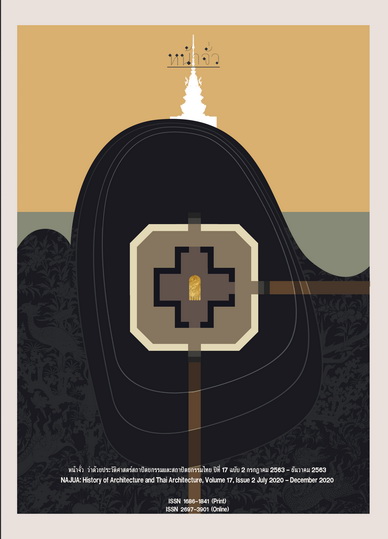Identical Characteristics of Tai Vernacular Houses in Mong Yawng, Shan State, Myanmar
Main Article Content
Abstract
The Tai in Mong Yawng in Shan State of Myanmar, known as Tai Yawng, are Tai Lue who migrated from Sibson Panna several hundred years ago. They brought the indigenous Tai Lue housing patterns and adopted some local patterns of Tai Yai and Tai Khun as well as some modern influences, resulted in the localized patterns. This study explored the villages and houses in this area which has not been researched extensively. Although unique and well-conserved, they are at risk of changes due to modernization and tourism accessibility to the area. The research focus is on the dynamics of architectural patterns as occurred in Tai vernacular architecture. Altogether four villages and nineteen houses are surveyed. The criteria for the selection of villages under study are ones that its villagers continue the peasant way of life and exist the Tai houses; the houses under study, are chosen from their ages of no less than 15 years whose indigenous Tai housing patterns remain. The field methods were based on observations and interviews with inhabitants, leaders and key persons in the area. The results from the survey reveal some identical Tai Lue housing patterns along with some adopted patterns of Tai Yai and Tai Khun. Some climatic adaptation and changes due to the needs and demands of households are also observable in the architecture, as resulted in unique characteristics of its elements.
Downloads
Article Details

This work is licensed under a Creative Commons Attribution-NonCommercial-NoDerivatives 4.0 International License.
References
Chu, Liang Hewin. chon chāt tai: sathāpattayakam læ khanopthamnīam praphēnī tai nai sip sō̜ng phan nā [The Dai or Tai and their architecture and customs in South China]. Translated by Ngarmpun Vejjajiva. Chiang Mai: Suriwong Book Center, 1994.
Kreangkrai Kirdsiri and Thanick Muenkhamwang. “rūpsong læ kānčhat wāng thī wāng phāinai rư̄an phư̄n thin thai lư̄: bānpǣn mư̄angnun sipsō̜ngpannā yūnnān sāthāranarat prachāchončhīn [House form and space organization of Dai Lue vernacular dwelling houses: Manbiancun Village, Menglunzhen, Xishuangbanna, Yunnan, People’s Republic of China].” NAJUA: History of Architecture and Thai Architecture 14 (2017): 172-197.
Ornsiri Panin. bān læ mūbān phư̄nthin [Local houses and villages]. Bangkok: The Association of Siamese Architects under the Royal Patronage, 1996.
Ornsiri Panin. khwāmlāklāi khō̜ng rư̄an phư̄n thin Thai [Diversity of Thai Vernacular House]. Bangkok: Faculty of Architecture, Silpakorn University, 2000.
Ornsiri Panin. “kān plīanplǣng rūp lak khō̜ng rư̄an phư̄n thin : kō̜ranī sưksā rư̄an thai khoēn chīang tung rat chān mīa nō̜mā [The transformation of the vernacular house appearance: Case study of the Tai-Kern vernacular housein Keng-Tung, Shan State, Myanmar].” NAJUA: Architecture, Design and Built Environment, no. 33 (January-December 2018): 21-38.
Ornsiri Panin. “sathāpattayakam phư̄n thin [Vernacular architecture].” In rư̄an phư̄n thin Thai-thai, [Thai Vernacular Houses- Tai], 5-8. Edited by Ornsiri Panin, and others. Bangkok: Faculty of Architecture, Silpakorn University, 2008.
Rawiwan Oranratmanee. thin thān bānrư̄an thai yai nai rat chān khwām chư̄am yōng thāng sathāpattayakam khō̜ng klum chāttiphan thai [Tai Yai Houses in Shan State: The architectural connection of the Tai Ethnic Group]. Bangkok: National Research Council of Thailand, 2015.
Rawiwan Oranratmanee. “thin thān bānrư̄an Thai yō̜ng [Tai Yawng house homeland].” In thin thān bānrư̄an Thai yō̜ng nai rat chān [Tai Yawng House Homeland in Shan State], 4-5. Chiang Mai: Faculty of Architecture, Chiang Mai University, 2014.
Rawiwan Oranratmanee. “sathāpattayakam phư̄n thin: kānsưksā wičhai læ kān patibat wichāchīp sathāpattayakam [Vernacular architecture: Architectural education, research and practice].” Journal of Faculty of Architecture, KMITL 8, 1 (2009): 56-66.
Sawaeng Malasam. “prawattisāt mư̄ang yō̜ng nai watthanatham thailư̄ - Thai won Phutthasatawat thī 18- Phō̜.Sō̜. 2101 [Yawng city history in Tai Lue-Tai Yuan culture 18th-22nd Buddhist century].” In prawattisāt thō̜ngthin khon yō̜ng yāi phǣndin [Local history Yawng people move the land]. 2nd ed., 1-40. Bangkok: Thammasat University Printer, 2001.
Sommai Premchit. tamnān mư̄ang lư̄: prawattisāt phư̄n thin dǣn din chīang rung mư̄ang yō̜ng mư̄ang sing [Legend of Lue States: Local history of Chiang Rung, Muang Yong and Muang Singh]. Chiang Mai: Lanna Education Project, Chiang Mai University, 2015.
Suebpong Chansuebsri. “samrūat chumchon tailư̄ bān kō̜ khō̜i mư̄ang yō̜ng læ bān dō̜nčhai mư̄ang sing phūmpanyā phatthanākān læ khwāmsamphan tailư̄ yāi thin sō̜ng fang khōng [Explore Tai Lue Village, Ban Ko Khoi, Muang Yawng and Ban Don Chai, Muang Sing, Knowledge development and relationships of the Lue migrate on both sides the Mekong.” In International Conference on Research and Design in Architecture and Related Fields, 67-88. Bangkok: Faculty of Architecture, Silpakorn University, 2016.
Thapanee Khruraya. “rư̄an læ khwām chư̄a kīeokap rư̄an khō̜ng chāo thai khoēn mư̄ang chīang tung rat chān sahaphāp mīanmā [House and beliefs about the house of Tai Khoen Keng-Tung, Shan State, Myanmar].” NAJUA: Architecture, Design and Built Environment, no. 26 (September 2011-August 2012): 161-177.
Thawee Sawangpanyangkun and Sawaeng Malasam. rư̄ang yō̜ tamnān mư̄ang yō̜ng [Synopsis of the legend of Muang Yawng]. Chiang Mai: Trio Advertising and Media Company Limited, 2011.
Thawee Sawangpanyangkun and Sawaeng Malasam. tamnān mư̄ang yō̜ng [The Legend of Muang Yawng]. Bangkok: Mit Nara Printing, 2014.
Wasan Panyakaew. lư̄ khām dǣn: kāndoēnthāng khō̜ng khon num sāo chāo lư̄ mư̄ang yō̜ng rat chān prathēt Phamā [Lue cross border mobility: Travel of Lue young people in Muang Yawng, Shan State, Myanmar]. Chiang Mai: Research and Academic Services Center, Faculty of Social Sciences, Chiang Mai University, 2012.
Wanida Phungsoontorn. “rư̄an tai lư̄ nai sip sō̜ng pan nā [Tai Lue house in Xishuangbanna].” NAJUA: Architecture, Design and Built Environment, no. 10 (January-December 1990): 12-36.


